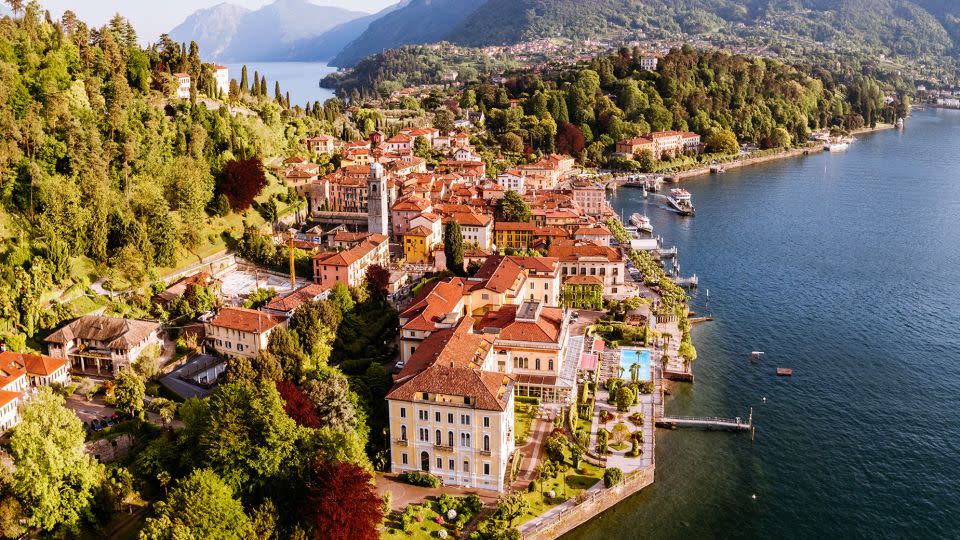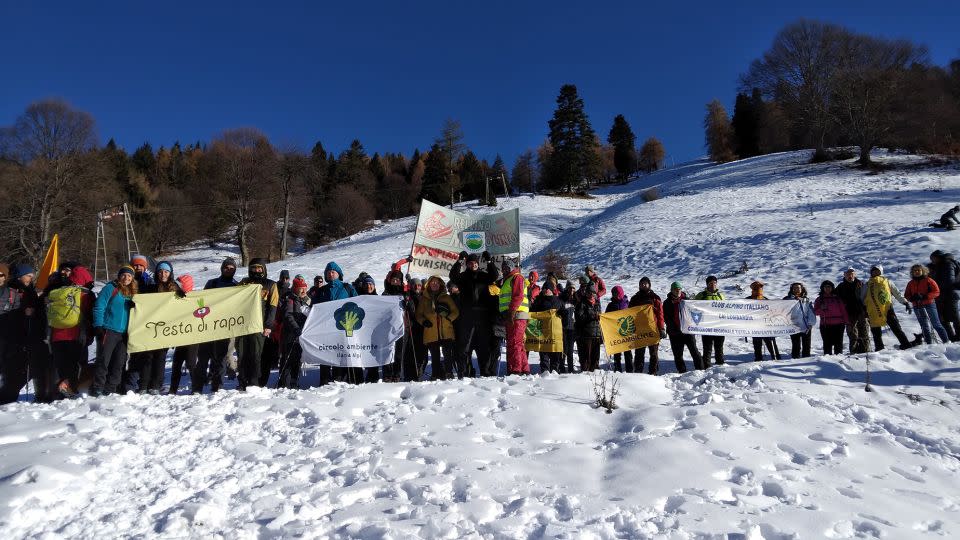An Italian ski resort shut down by climate change plans to reopen with artificial snow. Not everyone is happy
There are few things Italians do better than dreaming big against the odds. Take the multi-million-dollar plan that’s been in the works since the 1990s to build the world’s longest suspension bridge across the Straits of Messina in the heart of Mafia land. Or the very existence of the city of Venice, built on a lagoon system that’s now better protected from extreme weather by mechanical flood gates that took more than 20 years to realize.
Now, plans to build a multi-million-dollar ski facility on a snowless northern Italian mountain may prove equally challenging.
The bald mountain is the Monte San Primo, a gorgeous 1,682 meter (5,518 foot) promontory that accounts for much of the landscape view from the north end of Lake Como. The quaint cobblestone city of Bellagio, at its base, is known as the “pearl” of the lake for beauty that has lured A-list celebs (and wealthy Russians), who own the majority of lavish villas nearby.
But ever since the city of Bellagio last year won the backing of the national and regional government to fund a ski area project that it hopes will lure winter tourists, there has been trouble in this mountain paradise.
The plan, priced at 5 million euros (about $5.4 million), would see the construction of a large parking lot, toboggan runs and new lifts in an area that was a thriving ski destination 50 years ago, but closed a decade ago to winter sports as temperatures rose and snowfalls thinned.

Tourism dollars
While there has been considerable local support from those who think that reviving the mountain’s ski infrastructure will bring in vital tourism dollars, the plans have received an icy reception from environmental and sporting organizations.
A consortium of 33 groups, including the World Wildlife Fund and the Italian Alpine Club, which calls itself “Let’s Save Monte Primo,” has been trying to halt the project and raise awareness about the mountain’s ecological fragility.
Roberto Fumagalli, a spokesperson for the group, insists there are better ways to inject 5 million euros into the area that will still bring in tourism revenues. He says the group has been trying in vain to engage in talks with the project’s backers, including 31 local councils.
“We don’t want to wait until we are out protesting the bulldozers,” Fumagalli told CNN. “It would be more productive to sit down now.”
The group has a number of concerns about the proposed plans that run the gamut from environmental to logistical. Instead of revamping the parking lot, its members insist it would be more ecological to invest in public transportation; instead of artificially restoring snow areas, they would like to see hiking trails enhanced since shorter winters mean a longer hiking season.
They are also concerned about energy consumption by the snow-making machines, damage to the mountain caused by bringing in heavy equipment, and whether, given the proximity to better ski areas, the investment could eventually become a burden to local taxpayers if the project doesn’t eventually pay for itself.
Fumagalli said the protest group could be willing to find a compromise, but only if the project’s supporters are willing to have a dialogue.
Letter to George Clooney
“We’ve sent registered letters, appeals, used social media, and no one ever responds,” he added.
The group even wrote to Lake Como’s most famous resident, Hollywood star George Clooney.
“He hasn’t responded, but we hope he will,” Fumagalli said, pointing out how when flooding lapped up against Clooney’s property in 2021, the star spoke out in support of the community over the damage.
The main problem, the protest group points out, is that Monte San Primo, despite its history as a ski destination, just doesn’t get enough snow now. That’s thanks to rising temperatures and droughts, which the climate crisis might make more severe and more frequent.
The mountain, which has become a year-round hiking destination, is a graveyard of former efforts to capitalize on more traditional winter pursuits.
Old turnstiles, ski lift pillars, and even a map of now-vanished pistes can still be found on the mountain. The last lifts closed in the early 2010s because annual snow accumulations just couldn’t support a ski season, especially so close to the Alps and Dolomite ranges, where snow is guaranteed.
Snow could become even more scarce in the future as the impacts of the climate crisis accelerate. A recent study by the non-governmental organization WaterAid and the UK’s Cardiff and Bristol universities found that extreme drought in northern Italy has doubled over the past two decades, punctuated by severe flooding, putting it on course for a climate similar to those experienced in parts of Ethiopia and the Horn of Africa.
“Both regions are facing increasing evaporation (most likely driven by higher regional temperatures) which leads to accelerated drying of the landscape between rainfall events,” the research points out.
Not exactly ski weather.
The threat of water shortages hasn’t dissuaded officials in Bellagio city and the surrounding Lombardy region, who say they will just build an artificial lake, fill it with water, and then draw from it to make artificial snow with snow cannons, according to the plans approved by the municipality seen by CNN.

‘Relaunching tourist attractiveness’
As well as the parking lot, toboggan runs and new lifts, the project includes the refurbishment of a long-abandoned hotel.
A “magic carpet” conveyor belt lift is also planned. Supporters say this would have less environmental impact as foundations wouldn’t need to be dug deep into the landscape, as they are with traditional lifts. The artificial lake, they argue, would serve the community in the summer, too, and act as a reservoir for rainfall.
Bellagio’s mayor, Angelo Barindelli, has warned supporters not to be “afraid” of naysayers. “It is an important agreement, a total investment of 5 million euros, now we just have to commit to getting it started quickly,” he said in a statement provided by his office.
Alessandro Fermo, the head of the Lombardy Regional Council, which also backs the plans, said protesters are out of line.
“It’s not my habit to contribute to controversies, but this time I can’t help myself,” he said recently in comments streamed on Facebook. “Bringing resources to the territory is a long and tiring job. An investment of 5 million euros is important to develop and relaunch the tourist attractiveness of the area in winter and in summer.”
Even if the city fathers won’t sit with the protesters to find a compromise, the project may never get off the ground due to infamous Italian bureaucracy that, if history is a guide, can slow down even the most optimistic plans by decades.
The first plans for the Monte San Primo ski area were passed and the money pledged in early 2022. The first bids were supposed to go out in November of last year.
To date, nothing has moved forward beyond the protests and the weather forecast, which does not include significant snow any time soon.
For more CNN news and newsletters create an account at CNN.com


